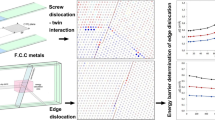Abstract
Complete and dissociated edge dislocations were created near the center of the surface (101) of aluminum small crystals whose surfaces are (111), (111−), (1−01), (101−). (1−21−) and (12−1). Molecular dynamics with N-body embedded atom potentials were used. Higher stress is needed to create a complete edge dislocation than to create a dissociated dislocation.
Similar content being viewed by others
References
D.J. Oh and R.A. Johnson, J. Materials Reseqrch, 3, 471 (1986).
D.J. Oh and R.A. Johnson, in Atomic Simulation of Mat4erials, edited by V. Vitek and D.J. Srolovitz, (Plenum Press, New York, 1989) p. 233–238.
Masao Doyama and T.M. Wang, Transaction of MRS-J (1994), (in press).
Author information
Authors and Affiliations
Rights and permissions
About this article
Cite this article
Tajima, N., Nozaki, T., Hirade, T. et al. Computer Simulation of Creation and Motion of Edge Dislocations in Face Centered Crystals. MRS Online Proceedings Library 356, 111–116 (1994). https://doi.org/10.1557/PROC-356-111
Published:
Issue Date:
DOI: https://doi.org/10.1557/PROC-356-111




